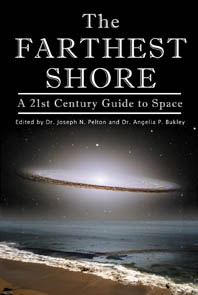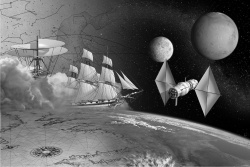The Farthest Shore – Foreword
From The Space Library
Foreword
Michael K. Simpson, Executive Director, Secure World Foundation and former President of the International Space University
In October 2017, we celebrated the 60th anniversary of the space age. Commonly dated from the launch of Sputnik on October 4, 1957, the space age saw an extraordinary evolution from one simple, human-made sphere orbiting the Earth for four months to an age where thousands of satellites in orbit are providing a range of services without which modern life would be very different. Along the way, humankind perfected the art of lofting representatives of our species into near Earth orbit, sending a few early voyagers to the surface of the Moon, and maintaining a permanent human presence on board the International Space Station.
Some of the authors contributing to this book were very early partici¬pants in the creation of the space age while others joined it along the way. To this extent at least, this volume is multi-generational. As such it may well point to one of the interesting questions of our time: is the first space age giving way to a new one? I believe that the answer is yes and when asked to explain what the difference between the two “ages” might be, I respond as follows:
In the first space age, human kind managed to send representatives into space and to apply novel space technologies in service to human society on Earth. In the next space age we will manage to send human society itself into space.
As our technologies improve to the point where we can already talk of the possibility of space tourism as an industry, we necessarily approach a time when groups of people might be willing to accept the rigors of perma¬nent migration beyond our home planet. I do not expect that vision to be realized in my lifetime, but I fully expect that it will be a choice available to my grandchildren and their families. In this way, too, the prospects of space are intergenerational.
Whether your interest in space is the result of a casual curiosity or of a deep desire to explore unknown places and ideas, I invite you to use this book as a tool to become more aware of the vast realm lying beyond Earth’s shallow atmosphere. I also invite you to reflect on the extraordinary confluence of professional disciplines, generational contributions, nation¬alities, and cultures that have combined and continue to combine to make this strange and wonderful realm a little more understandable each day.
In 1938, writing in his book, The Evolution of Physics, Albert Einstein confessed his resignation with humankind’s confinement to the Earth:
Unfortunately, we cannot place ourselves between the Sun and the Earth… This can only be done in imagination. All our experiments must be performed on the Earth on which we are compelled to live.
Fifty-one years later, human beings were walking on the Moon.
As you use this book to extend your knowledge beyond what even Einstein could know in 1938 understand that for you, too, there will be a constant need to renew your understanding and rethink the limits of our species.
When members of the ISU community describe the values that have bonded them to this special school, they invariably refer to the “3i’s.” Their experience whether as teacher, student, staff member, trustee, or sponsor has been forged in an environment that was intentionally international, intercultural and interdisciplinary. Increasingly with a commitment to con¬tinuous renewal of the vision, many of us add a fourth “i” as well: inter-generational.
The International Space University could hardly live up to its interna¬tional mission were it merely an assembly of people from a few scattered countries. In fact, its Masters and Space Studies Programs (SSP) so regu¬larly enroll students from many countries that ISU is increasingly sought after as a host for special symposia and workshops whose themes demand the broadest global perspectives. With a global faculty representing 15 nationalities and students from more than 25 each year in the Masters and the SSP, ISU has managed in only 21 years to develop a network of gradu¬ates representing 100 different countries.
Equally as important as these numbers is that ISU has maximized the opportunity for people of different national origins to work closely with each other, solve problems collaboratively, and discover the rich benefits of diverse perspective as a problem-solving tool. Through intense team projects and hands-on experiences, ISU provides its students with the chance to work with one another on complex problems. With common objectives but often widely differing methods of work, ISU students come to terms with their differences and grow beyond the boundaries of their national backgrounds.
Similarly, they learn to work within their diversity of culture by bring¬ing to bear habits of mind and problem-solving approaches that often differ widely even within the same nationality. Learning to speak openly about their assumptions and thoughtfully about their perspectives, ISU students discover how to form bonds of synergy that often escape professionals who may never have had the experience of seeing difference as a fount of opportunity rather than a cause of error.
In many ways, the habits of mind we acquire in our professions and in the specialized training that prepares us for them represent a particular kind of culture, but one so special as to merit separate attention. Genera¬tions of ISU students have come away from their experience in this school with the impression that of all the challenges inherent in the 3i approach, the challenge of interdisciplinary cooperation is often the most difficult. Lawyers think differently than do engineers. Natural scientists often look at a problem very differently than do economists. Social scientists have habits of communication than are very different than those of health pro¬fessionals. Yet, with the right opportunity to see the value that multiple perspectives and professional paradigms can bring to the process of seek¬ing solutions to complex problems, a well-rooted faith in the power of synergy is possible.
It is from this vision that this volume is born. From the multiple beau¬ties and myriad challenges of Earth to the farthest shore of humankind’s ability to dream and to venture, this book seeks to present space as both a distant destination for our species and an intriguing neighborhood for our fragile planet. It emerges from the collaboration of many people, trained in many cultures and professional traditions. It is rooted in the belief that the challenge of tomorrow is in using and exploring the opportunities of space. But we will only succeed in this leap toward the Farthest Shore by harnessing the talent of men and women from around the world.
Enjoy the journey.


